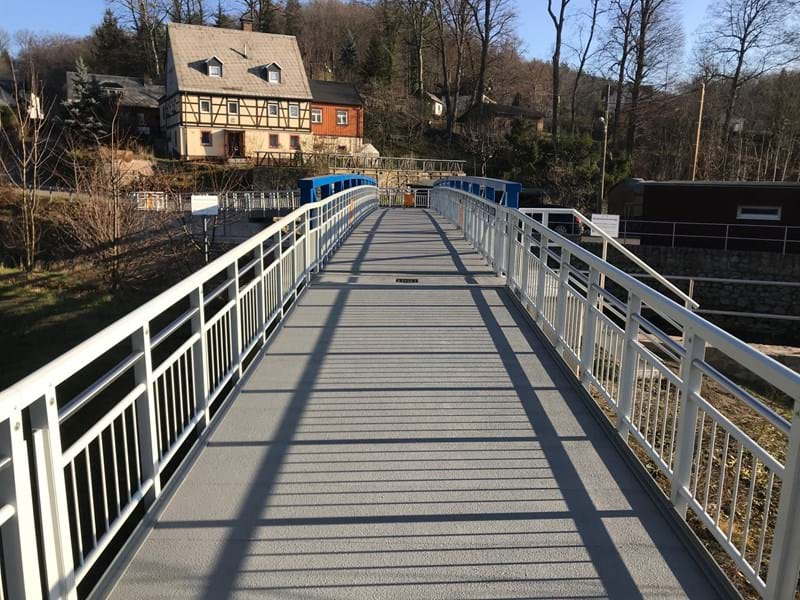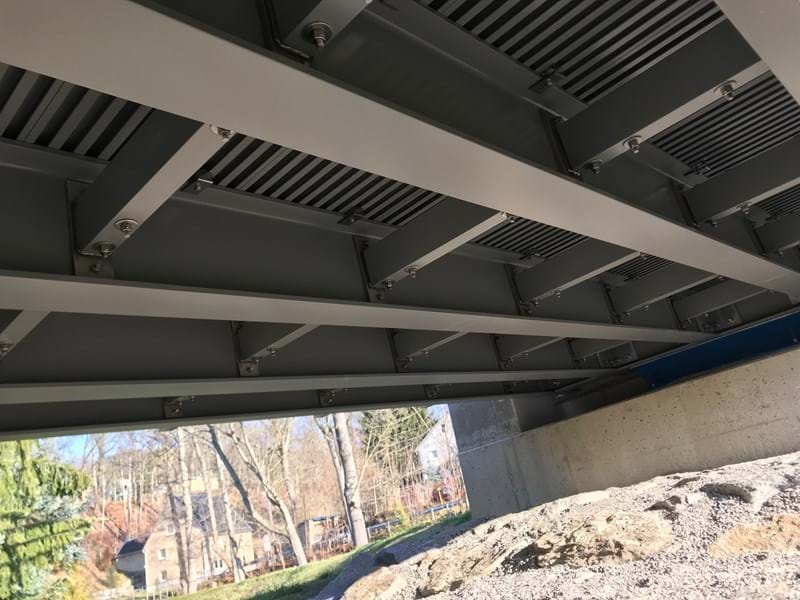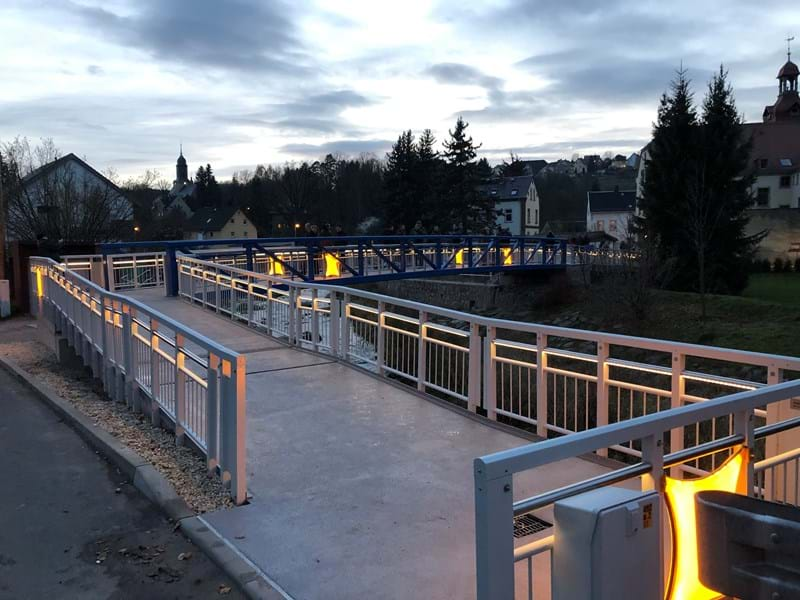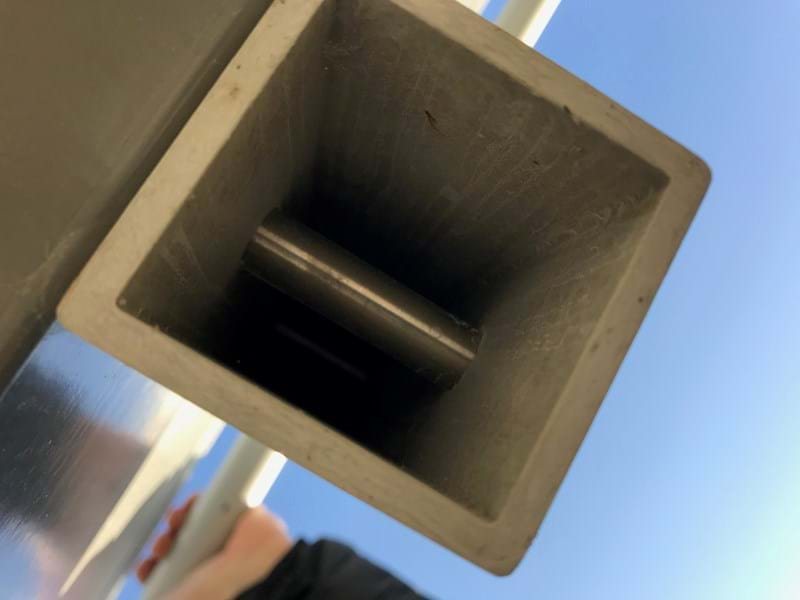

Fiberline Building Profiles A/S
73 meters long. Structural profiles, HD planks and FBD300 planks Placement: Chemnitz, Germany
The new bridge in Chemnitz is with its 73 meters one of the biggest fibreglass bridges in Germany. It has been designed to withstand flooding for the next 100 years – and is virtually maintenance-free.
Flooding is common in Central Europe given the region's many wide rivers. The German town of Chemnitz, which lies close to the Czech border, was badly flooded in June 2013, causing the town's Einsiedel district to completely lose its bridge. History will not repeat itself for the town's new bridge, however, which has been designed, in theory, to withstand flooding for the next 100 years. For this project, the brief was to create a light and supple structure that is optimised in terms of both energy and resource consumption.
“The technical demand of lightweight constructions is to design and manufacture systems that are characterized by a reduced weight and increasing quality of use”, Thomas Müller, engineer for City of Chemnitz.
A significantly lighter end product means fewer demands on so-called co-products such as foundations. It also means zero need for specialist machinery during the installation process.
The bridge is 73 meters long and includes a ramp which ensures a barrier-free cross-over of the Zwönitz river. The bridge was built using efficient resources: the fibreglass profiles (GRP) are corrosion-free and therefore resistant to weather, salt water and UV rays. Thanks to these durable GRP profiles, maintenance is minimal, and no expensive replacements will be required over the entire lifetime of the bridge.
"From a life cycle perspective, GRP is an attractive choice because it's so strong and durable. Our first bridge is over 20 years old, and tests have shown that its mechanical properties have not changed in all that time. Even though the bridge is located close to the coast, the only maintenance needed so far has been the removal of graffiti,” says Christian Scholze, Technical Solution Manager at Fiberline.
Read the full story of Fiberline's first bridge, Fiberline-bro in Denmark.
The bridge consists of four GRP ramps, which are each comprised of Fiberline structural profiles and HD planks. FBD300 planks were also used; these were glued onto a steel construction to cover the width over the widest part of the river. Thanks to the recognised certifications and consistently high level of quality, using Fiberline products meant that it was easier to get approval for the project design.
“All Fiberline structural profiles and HD planks have DiBT approval (German building permission), which means that it is not necessary to obtain approval in individual cases. An approval in principal was only necessary for the FBD 300 decking, which was used for the decking of the main bridge. But here, too, Fiberline provided us with full documentation that made it easy for approval,”Franziska Pfalz, FIBER-TECH, sub-contractor on the project”
Fiberline is one of only a few companies to have a CE mark for GRP structural profiles. This makes it easier to get construction projects approved throughout the EU.
As well as having the necessary and recognised certifications, construction advice was also essential to the project. Working with GRP – which for many is still a new and unfamiliar material – requires a different approach both in terms of construction and processing.
”We were in the fortunate situation to be working with the University of Chemnitz and with two of the best known companies in fibreglass construction, namely Fiberline A/S and Fiber-Tech Construction GmbH”, Thomas Müller, City of Chemnitz
In the two production halls in Chemnitz FIBER-TECH has CNC-machined, coated, pre-assembled and afterwards mounted the pultruded GRP profiles from Fiberline with lengths up to 12 meters.
The new bridge, which connects the bottom of the embankment with the high street, gives tourists, design aficionados and the wider community the chance to enjoy a beautiful river accentuated by different structures, with the bridge itself constituting a modern piece of construction in harmony with its natural surroundings.
“The construction consists of GRP gratings, steel beams, GRP bridge deck and GRP handrail with 6 illuminated tubes. With this creation the city of Chemnitz has acquired a unique and individual bridge design with high recognition value”, Franziska Pfalz, FIBER-TECH, sub-contractor on the project”
The bridge is part of the flood protection and was completed as planned in November 2019. Building began in September 2018 and after just 13 months, the bridge was finished, complete with railings, connections, modern LED lighting and public access roads. It was the result of a close collaboration with the municipality and consulting engineers, and of a speedy production and assembly process undertaken by Fiberline and FIBER-TECH.
The total costs, including the cost of dismantling the damaged bridge, all connectivity work, planning, inspections and construction, came to just under two million EURO.
See the official project report here



















Learn more about GRP bridges.